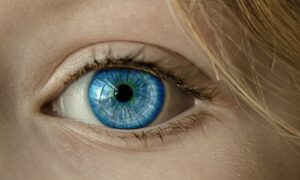by James Scott Bell
@jamesscottbell
 She put one hand behind her and flipped the snap of her halter and tossed it to the floor, staring at him with eyes of liquid smoke in which there was a curious and great disinterest. – From Here to Eternity by James Jones
She put one hand behind her and flipped the snap of her halter and tossed it to the floor, staring at him with eyes of liquid smoke in which there was a curious and great disinterest. – From Here to Eternity by James Jones
Eyes. Windows to the soul. “Traitors of the heart,” Thomas Wyatt put it. He would know. He was accused of ruffling the sheets with Anne Boleyn and got to write his poems in the Tower.
So yes, eyes are important. We look people in the eye when we meet them. (If someone doesn’t look at your eyes when they meet you, watch your back!)
It’s the same with characters, isn’t it? The reader forms a picture of a character—eyes included—whether you choose to describe them or not.
So the first decision you make is whether to include orb details at all. My own preference is to describe them for major and strong secondary characters. Most minor characters and “spear carriers” (those little one-offs needed for a scene, like a waiter or doorman) usually don’t need them.
Once we decide to describe the eyes, we usually first think of color. Something along the lines of She had blue eyes and wore a yellow dress. Functional but not memorable. More lush is Margaret Mithcell’s famous opening to Gone With the Wind:
Scarlett O’Hara was not beautiful, but men seldom realized it when caught by her charm as the Tarleton twins were. In her face were too sharply blended the delicate features of her mother, a Coast aristocracy of French descent, and the heavy ones of her florid Irish father. But it was an arresting face, pointed of chin, square of jaw. Her eyes were pale green without a touch of hazel, starred with bristly black lashes and slightly tilted at the ends.
(Note: those green peepers were so important to fans of the book that when blue-eyed Vivien Leigh was cast as Scarlett for the movie, there was an uproar. Producer David O. Selznick took care of that by having yellow lights trained on Leigh’s face in closeups, turning blue to green.)
You can add to the color by including the effect the eyes have on the viewpoint character, as in Richard Prather’s noir story “The Double Take”—
Her eyes were an incredibly light electric blue—shooting sparks at me.
Similar is the description of Hannibal Lecter in The Silence of the Lambs:
Dr. Lecter’s eyes are maroon and they reflect the light in pinpoints of red. Sometimes the points of light seem to fly like sparks to his center. His eyes held Starling whole.
David Copperfield describes the first time he saw the face of Uriah Heep:
It belonged to a red-haired person—a youth of fifteen, as I take it now, but looking much older—whose hair was cropped as close as the closest stubble; who had hardly any eyebrows, and no eyelashes, and eyes of a red-brown, so unsheltered and unshaded, that I remember wondering how he went to sleep.
While color is our natural default when describing eyes, it’s not a requirement. A popular alternative is metaphor.
His eyes were wet wounded rugs.
(Revenge of the Lawn by Richard Brautigan)He hadn’t shaved for four or five days. His nose was pinched. And his eyes were like holes poked in a snowbank. (The Long Goodbye by Raymond Chandler)
I’ve been in front of X-ray machines that didn’t get as close to the bone as that woman’s eyes. (The Name of the Game is Death by Dan J. Marlowe)
She had a lot of face and chin. She had pewter-colored hair set in a ruthless permanent, a hard beak and large moist eyes with the sympathetic expression of wet stones. (The High Window by Raymond Chandler)
Richard Matheson’s famous Sci-Fi story “Lover When You’re Near Me” takes place in the distant future on a colonized planet inhabited by creatures called Gnees.
He sat there, momentarily reflecting on her eyes. They were huge eyes, covering a full third of her face; like big glass saucers with dark cup rings for pupils. And they were moist; bowls of liquid.
I’m saving the best for last. Here is an eye description I’ve never forgotten, so perfectly did it capture a character. It’s from Darker Than Amber by the great John D. MacDonald:
She sat up slowly, looked in turn at each of us, and her dark eyes were like twin entrances to two deep caves. Nothing lived in those caves. Maybe something had, once upon a time. There were piles of picked bones back in there, some scribbling on the walls, and some gray ash where the fires had been.
The eyes have it—perhaps more than any other descriptive element they can give us a sense of who the character is and what mysteries dwell within. Use color, metaphor, and/or the effect the eyes have on the viewpoint character, and your fiction will be looking good.
How do you go about describing the eyes of your characters?
